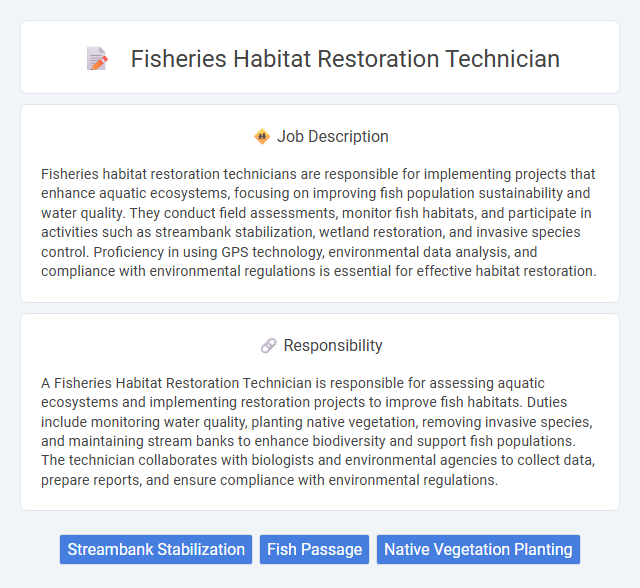
Fisheries habitat restoration technicians are responsible for implementing projects that enhance aquatic ecosystems, focusing on improving fish population sustainability and water quality. They conduct field assessments, monitor fish habitats, and participate in activities such as streambank stabilization, wetland restoration, and invasive species control. Proficiency in using GPS technology, environmental data analysis, and compliance with environmental regulations is essential for effective habitat restoration.
Individuals with a strong interest in environmental science and physical stamina are likely well-suited for a Fisheries Habitat Restoration Technician role. Those who enjoy hands-on work, navigating outdoor environments, and collaborating with diverse teams may find this job particularly fulfilling. However, candidates with limited physical endurance or discomfort working in variable weather conditions might face challenges adapting to the demands of the position.
Qualification
Fisheries habitat restoration technician roles require strong knowledge of aquatic ecosystems, environmental science, or natural resource management, often supported by a bachelor's degree in biology, ecology, or a related field. Practical experience in habitat assessment, data collection, and the use of GIS mapping tools is highly valued, alongside skills in species identification and monitoring. Physical stamina and the ability to work in field conditions, combined with certifications in first aid or boating safety, enhance job performance in restoration projects.
Responsibility
A Fisheries Habitat Restoration Technician is responsible for assessing aquatic ecosystems and implementing restoration projects to improve fish habitats. Duties include monitoring water quality, planting native vegetation, removing invasive species, and maintaining stream banks to enhance biodiversity and support fish populations. The technician collaborates with biologists and environmental agencies to collect data, prepare reports, and ensure compliance with environmental regulations.
Benefit
Fisheries habitat restoration technician roles likely offer significant benefits, including opportunities to work outdoors in diverse ecosystems, which can enhance career satisfaction and physical well-being. The position may also provide valuable hands-on experience with conservation techniques, increasing employability in environmental science fields. Furthermore, these jobs often contribute to meaningful ecological outcomes, potentially boosting personal fulfillment and community impact.
Challenge
Fisheries habitat restoration technician roles likely involve complex challenges related to balancing ecosystem needs with human activity impacts, demanding innovative problem-solving skills. The probability of encountering unpredictable environmental conditions requires adaptability and resilience to ensure successful habitat rehabilitation. Fieldwork may present physical and logistical obstacles that test technical expertise and collaborative efforts among stakeholders.
Career Advancement
Fisheries habitat restoration technicians build hands-on expertise in aquatic ecosystem rehabilitation, paving the way for advanced roles in environmental science and natural resource management. Mastery in field assessments and habitat improvement techniques often leads to specialized positions such as fisheries biologist or environmental consultant. Continued professional development through certifications and experience opens opportunities for leadership roles within conservation agencies and environmental organizations.
Key Terms
Streambank Stabilization
Fisheries habitat restoration technicians specialize in streambank stabilization to prevent erosion and enhance aquatic ecosystems. They implement bioengineering techniques such as installing coir logs, live stakes, and native vegetation to reinforce streambanks and improve water quality. Their work supports fish populations by creating stable habitats that reduce sedimentation and promote biodiversity.
Fish Passage
Fisheries habitat restoration technicians specialize in enhancing aquatic ecosystems by improving fish passage through barriers such as dams, culverts, and natural obstructions. They conduct field assessments, install fish ladders, and monitor water flow to ensure migratory fish species can access critical spawning and rearing habitats. Expertise in environmental regulations and aquatic biology is essential for designing effective restoration projects that support biodiversity and fish population recovery.
Native Vegetation Planting
Fisheries habitat restoration technicians specialize in native vegetation planting to improve aquatic ecosystems and support fish populations. They select and cultivate indigenous plant species that stabilize stream banks, reduce erosion, and enhance water quality. These efforts create vital habitats for fish spawning and rearing, promoting biodiversity and sustainable fisheries management.
 kuljobs.com
kuljobs.com